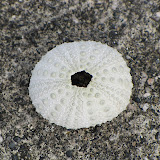 As mentioned in the previous post, we were accompanied by Dr. Stanley Heckadon – Moreno Director of Communications and Public Programs at Punta Galeta Marine Biology Laboratory.
As mentioned in the previous post, we were accompanied by Dr. Stanley Heckadon – Moreno Director of Communications and Public Programs at Punta Galeta Marine Biology Laboratory.This is another Smithsonian field station. Here scientists study the mangrove forests, the seagrass beds, and the coral reefs, the three major components of costal marine biology. This is a much smaller site than BCI. They can only accommodate about 16 people whereas BCI can house about 100 scientists. Also notably different from BCI, is the emphasis put on educational outreach and environmental conservation.
One of the ways that Dr. Heckadon reaches out to the community is by recruiting volunteers from in and around Colón. He assigns them to a research and they start by assisting. Then gradually, they are given more responsibilities. Ultimately, volunteers can become guides and transition to the payroll. Our guide for the day was Gabriel Thomas.
 First Gabriel showed us the open system aquariums. They are termed open system because there is a pump that is bringing sea water directly from the ocean into each of the tanks. They each have a pipe on the opposite side that returns water to the sea. One of the drawbacks to not having a closed system (like a typical aquarium at home) is that one cannot regulate the temperature of the water. This is problematic because the water they are drawing from to bring to the tanks is in relatively shallow water that varies a good deal in temperature. Many corals cannot withstand such variability.
First Gabriel showed us the open system aquariums. They are termed open system because there is a pump that is bringing sea water directly from the ocean into each of the tanks. They each have a pipe on the opposite side that returns water to the sea. One of the drawbacks to not having a closed system (like a typical aquarium at home) is that one cannot regulate the temperature of the water. This is problematic because the water they are drawing from to bring to the tanks is in relatively shallow water that varies a good deal in temperature. Many corals cannot withstand such variability.We walked into the Mangroves on a boardwalk. Mangroves are a costal tree that grow on stilted roots and depend on saltwater. The habitat they grace is being destroyed at a staggering rate, and the coast near Colón is no exception. Mangroves provide an important barrier for rainwater runoff, preventing excess silt and topsoil from running into the sea. They also slow the tidal action as the water comes running in, which cuts down on erosion and actually allows more sediments to settle in the area around the mangroves. The stilted roots also provide priceless protection to many species of fish for laying eggs and rearing young. Large areas of Mangroves are being destroyed every year to make way for large 'bodegas' - gigantic warehouses that house shipping containers awaiting export in the 'Free Trade Zone'.
It is a beautiful place to visit, bustling with friendly locals, students, volunteers, and scientists. Although it is a modestly sized facility, there are many reasons to return! For example, April 2010 marks the fourth year that the folks at Galeta are offering a two-week course in tropical marine ecology, science content and methods for Panamanian teachers.
To learn more about what Galeta has to offer, visit Galeta



No comments:
Post a Comment